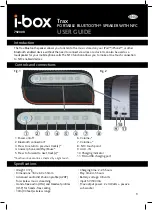
July 05
5
CONNECTING THE AN-E/D
Before making any connections always turn off your amplifier.
The length and type of speaker cable used in your system will have an audible effect. The
AN-E/D
is wired internally with a high quality Audio Note cable, type
AN-D
. It is recommended that you
use a similar type of speaker cable in order to maintain the tonal balance and dynamic
characteristics that we designed the
AN-E/D
for.
Although the binding posts on the back of the speakers accept bare wire, it is recommended that
the cable is terminated with soldered 4mm banana plugs. Even if it seems unnecessary, it is
advisable to use equal lengths of speaker cable to each speaker.
Most speaker cable is marked so that it is possible to distinguish between conductors by the colour
of the insulation or by a white stripe or small raised edge along one conductor. Correct phasing of
the speakers is vital for sound quality.
Very tight and positive connections are necessary. Care should be taken to ensure that the
connections are neat and that no strands from the two conductors are allowed to touch.
At the rear of each speaker there are two pairs of red and black terminals marked LF and HF.
Under normal operating conditions these pairs are linked across by connecting links (this is how
they arrive to you from the factory), so that the input to one pair of terminals will be fed to both.
Your speakers should be wired in phase with each other. Proper phasing will be assured if the
speaker cables connect the red speaker input to the plus (+) or “hot” amplifier output terminals, and
the black speaker input terminals to the negative (-) or “ground” amplifier output terminals (see
figure 1).
Should you be interested in absolute phase of your system, a positive voltage at the red terminal of
the speaker will cause all drivers to move outward, provided the links are in place.
The facility to split the crossover on the AN-E/D allows the speakers to be operated in a bi-wired
or bi-amplifier mode. The crossovers are split by removing the connecting links between the HF
and LF terminals on the rear of the speaker. Bi-wiring (see figure 2) involves running two sets of
cables to the rear of each speaker so that the LF section of the crossover is fed by one set and the
HF section by the other. Both sets of cable are connected together to the corresponding pair of
terminals on the back of the amplifier. Two preamplifier outputs per channel are required for any
of the following bi-amping set-ups.
It is strongly recommended that the same type of speaker cable is used throughout.




























